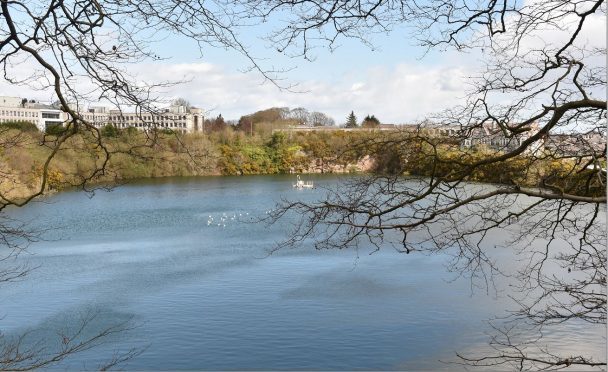Ambitious £68million housing plans at Aberdeen’s iconic Rubislaw Quarry have been rejected by the Scottish Government.
Canadian firm Carttera (corr) had their original vision for the site – featuring a 10-storey building of 299 rented flats, a gym, mini-museum and public bistro – refused by the council’s planning committee last June following hundreds of objections from local residents.
Carttera then appealed to the Scottish Government, which has upheld the decision.
But the firm last night vowed to fight on and submit a new application in “the near future”.
In a 15-page summary, Scottish Government Reporter Claire Milne warns there would be an “adverse impact” visually if the development were to proceed.
She visited the site in September and November ahead of her decision.
Ms Milne wrote: “Overall, I find the proposal would represent over development with consequent adverse impacts in terms of visual amenity.
“…the proposed development does not accord overall with the relevant provisions of the development plan and that there are no material considerations which would still justify granting planning permission.
“I have considered all the other matters raised, but there are none which would lead me to alter my conclusions.”
Quarry owner Hugh Black, who had his own £6million plan for a museum on the city’s granite heritage, vigorously opposed the plans.
However, in December Mr Black’s planning permission also expired leaving the future of the quarry uncertain.
But Mr Black vowed to go back to the drawing board and hinted that a new “plan B” will be revealed.
A Carterra spokesman said: “We are disappointed with the decision, however there are many positives to be taken from the report.
“We will analyse this and be liaising with our architects to prepare a revised application in the near future.”
Hazlehead, Queens Cross and Countesswells councillor Martin Greig moved the planning committee motion to refuse the scheme.
Last night he said: “I am delighted that the Scottish Government has supported my motion to throw out this application.
“Local opposition to this excessive development has been overwhelming. It us reassuring that the government has sided with the community.”
Last night Hugh Black said: “This decision from the Scottish Government is very welcome and rubberstamps the correct decision taken some months ago by the local planning committee, to refuse this planning application.
“This sends out a clear message that development around Rubislaw quarry must respect the historical importance of the site and that this type and scale of development, is totally unacceptable.”
The history
The quarry was once the home of Aberdeen’s granite industry – giving the silver city it’s iconic look.
Opened in 1740, it continued producing building materials until 1971, by which time some six million tonnes of the stone had been excavated.
In recent years, multiple new uses have been mooted for the site – including the competing projects put forward by quarry owner Hugh Black and Canadian firm Carterra.
Permission was originally granted for Mr Black’s £6 million scheme for a heritage centre celebrating the history of the quarry in December 2015, despite concerns for a number of trees on the site.
Mr Black, who bought the site with business partner Sandy White in 2010, had to apply to the powerful Lands Tribunal to vary conditions to allow for his dream.
This was refused in January of last year.
Carterra unveiled its own plans for a massive £68 million, 299-home scheme, featuring a gym, mini-museum and public bistro.
But the scheme has proved highly controversial in the area, attracting more than 350 objections.
Concerns were raised about the potential impact on animals living at the site, an increase in parking problems and the 10-storey height of the buildings on the landscape
Last June, the council’s planning committee refused permission and now their appeal to the Scottish Government has also been turned down.
On Christmas Eve, Mr Black’s planning permission for his vision expired.
He has hinted at a “plan B” for the site.
